 Part two of our tour took us to the Royal Barbados Cigar Company. Here, they make cigars completely by hand.
Part two of our tour took us to the Royal Barbados Cigar Company. Here, they make cigars completely by hand.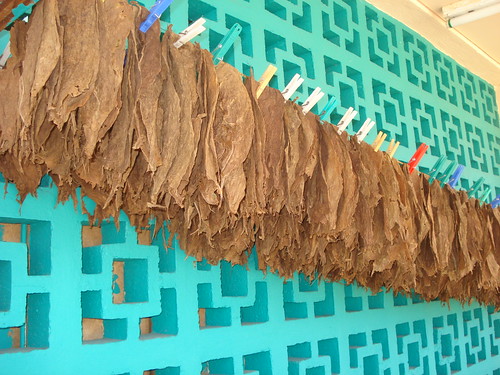 When we arrived, we were greeted with yards and yards of hanging, dried tobacco leaves. As someone who has almost always been repulsed by the smell of tobacco (unless of course we're talking about sweet, sticky, molasses-y hookah smoke), to the smell outside the factory here wasn't exactly pleasant to my precarious nose. But, if you like that sort of thing, the drying Cuban tobacco probably would have been pleasant.
When we arrived, we were greeted with yards and yards of hanging, dried tobacco leaves. As someone who has almost always been repulsed by the smell of tobacco (unless of course we're talking about sweet, sticky, molasses-y hookah smoke), to the smell outside the factory here wasn't exactly pleasant to my precarious nose. But, if you like that sort of thing, the drying Cuban tobacco probably would have been pleasant. Once inside the factory, we met with the Swiss woman that ran the place with what appeared to be an iron fist. I didn't get a picture of her, but Brian does a great impression of her that I wish I could share with you. Anyhow, Some of the women didn't like to have their pictures taken, but they did allow me to take pictures of their work. In this shot, the woman is unraveling Cuban tobacco to be sorted.
Once inside the factory, we met with the Swiss woman that ran the place with what appeared to be an iron fist. I didn't get a picture of her, but Brian does a great impression of her that I wish I could share with you. Anyhow, Some of the women didn't like to have their pictures taken, but they did allow me to take pictures of their work. In this shot, the woman is unraveling Cuban tobacco to be sorted. Once the leaves are flattened out and orderly, they're sorted into small, medium, and large. These are the leaves that will determine the size (re: 'number') of the cigar. These leaves were from Ecuador and Cameroon. For those of you too anxious to wait for the embargo on Cuba to disappear, she did tell us that even though the cigars are Cuban tobacco, they are importable to the US because they are a product of Barbados.
Once the leaves are flattened out and orderly, they're sorted into small, medium, and large. These are the leaves that will determine the size (re: 'number') of the cigar. These leaves were from Ecuador and Cameroon. For those of you too anxious to wait for the embargo on Cuba to disappear, she did tell us that even though the cigars are Cuban tobacco, they are importable to the US because they are a product of Barbados.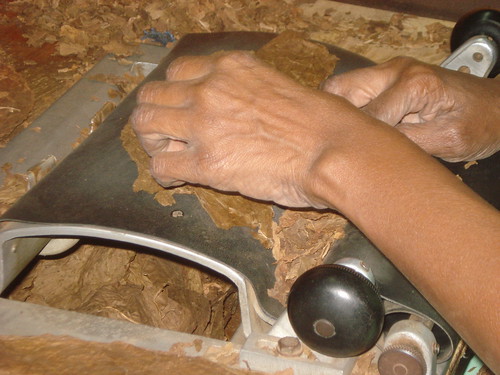 At the next station, we watched one woman stuff the tobacco leaves into the wedge on the rubber roller, while the whole leaf was stationary on the top.
At the next station, we watched one woman stuff the tobacco leaves into the wedge on the rubber roller, while the whole leaf was stationary on the top. She adjusts it and then rolls all of the filler into the larger leaf wrapping. I couldn't believe how many times our Swiss 'guide' said the word nice in describing how this is done. I think she must've said it 30 times. Nice!
She adjusts it and then rolls all of the filler into the larger leaf wrapping. I couldn't believe how many times our Swiss 'guide' said the word nice in describing how this is done. I think she must've said it 30 times. Nice! Once the filler is done and the cigar is first rolled up, they're placed in these blocks. The block ensures that the cigars are a uniform shape and size for the number that they are producing that day.
Once the filler is done and the cigar is first rolled up, they're placed in these blocks. The block ensures that the cigars are a uniform shape and size for the number that they are producing that day.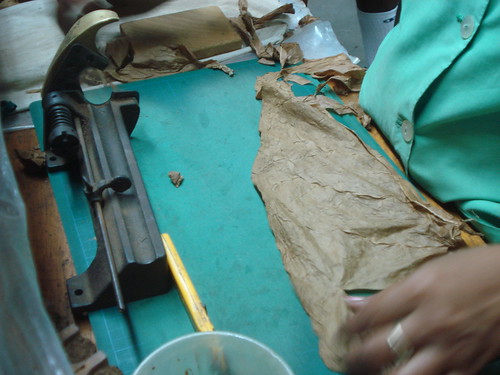 In the next step they take an extra large tobacco leaf that has been stripped until it is thin and extremely pliable. She cuts it down to a size that is relative to the size of the cigar. Then, the cigar is rolled inside the final wrapping until it appears flawless. The woman who rolls the cigar then cuts the leaf again and seals the ends with a natural, vegetable-based glue like guar gum. They don't want you to fire up your cigar and burn chemical glue and poison yourself. So a vegetable gum it is. Follow the pictures of the process below:
In the next step they take an extra large tobacco leaf that has been stripped until it is thin and extremely pliable. She cuts it down to a size that is relative to the size of the cigar. Then, the cigar is rolled inside the final wrapping until it appears flawless. The woman who rolls the cigar then cuts the leaf again and seals the ends with a natural, vegetable-based glue like guar gum. They don't want you to fire up your cigar and burn chemical glue and poison yourself. So a vegetable gum it is. Follow the pictures of the process below: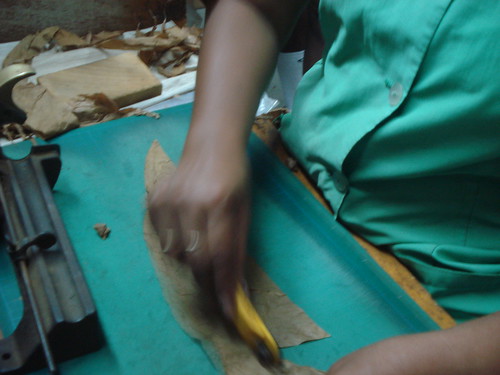
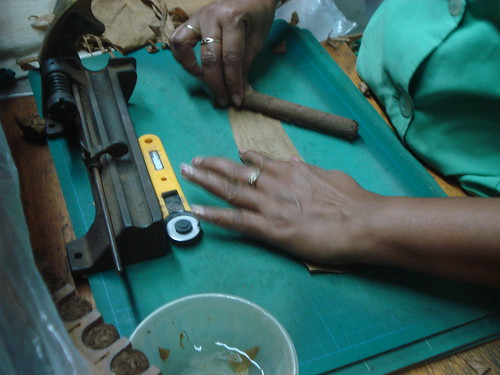
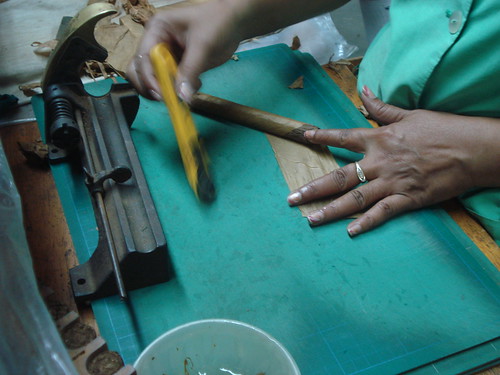


After the cigars are glued and dry, they move on to the next step in the process, were they receive their pedigree.
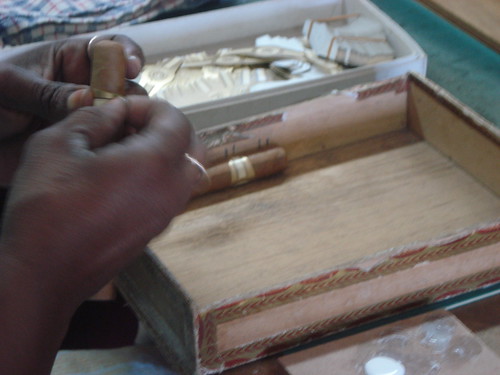 The cigars are labeled by hand and each label gets a small dab of Elmer's glue. The glue is not supposed to ever touch the cigar skin, otherwise the cigar is rubbish and has to be thrown out.
The cigars are labeled by hand and each label gets a small dab of Elmer's glue. The glue is not supposed to ever touch the cigar skin, otherwise the cigar is rubbish and has to be thrown out.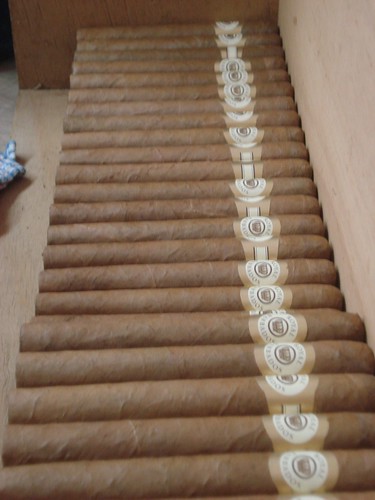 After they're labeled, the cigars still have one more step of QC. They must be matched perfectly by color. At this point, the woman working on the cigars held up two of "differing" colors to the light. I thought to myself, I'd be fired from this job, because I can't tell the difference. They all look like they're the same color to me. If you look at the picture above, can you tell the difference?
After they're labeled, the cigars still have one more step of QC. They must be matched perfectly by color. At this point, the woman working on the cigars held up two of "differing" colors to the light. I thought to myself, I'd be fired from this job, because I can't tell the difference. They all look like they're the same color to me. If you look at the picture above, can you tell the difference?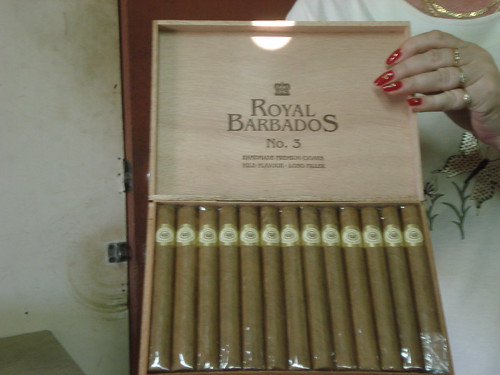 Finally, the cigars receive individual cellophane wrappings. They are boxed and ready for presentation. For more information about Royal Barbados Cigars, go here.
Finally, the cigars receive individual cellophane wrappings. They are boxed and ready for presentation. For more information about Royal Barbados Cigars, go here.
This is so cool! I had no idea that this is how they make cigars! It's cool that they let you take photos too- if I ever get the chance I'll take a tour of a place like that.
ReplyDeleteThis article along with the photos is quite helpful for the Cigar lovers those who smoke them but never had any idea of their preparation.A person can have a detailed knowledge of the Cigars right from the raw tobacco leaves till they are packed in fascinating covers.Really i also got amused to see the photos and the delicacy demonstrated by these women to produce a beautiful & tasty Cigar.I think the famous Cohiba Cigars are prepared in the same manner.
ReplyDelete